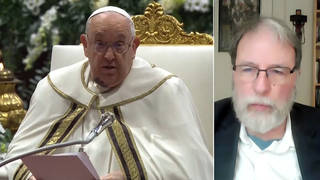
Topics
Oscar-winning actor Geena Davis is the founder of the organization See Jane. It works to increase the percentages of female characters — and to reduce gender stereotyping — in media made for children. Geena Davis recently spoke at the National Conference for Media Reform. [includes rush transcript]
Transcript
AMY GOODMAN: We turn now to the Oscar-winning actor, Geena Davis. She starred in many films, including Thelma and Louise and A League of Their Own. Geena Davis is also founder of the organization See Jane. It works to increase the percentages of female characters and reduce gender stereotyping in media made for children. Geena Davis recently spoke at the National Conference for Media Reform in Memphis, Tennessee. She began by talking about her film Thelma and Louise.
GEENA DAVIS: We were totally unprepared for the reaction that the movie got. Like before the movie came out, for example, if I was at the cleaners or something, somebody might say, “Oh, you know what? I actually loved Earth Girls Are Easy” or, you know, something like that. After was night and day. Suddenly women were coming up to me and saying, “That movie changed my life. Oh, my god, you have no idea! My girlfriend and I re-enacted your trip.” Or one time I was parked at a red light, and I heard this wild honking next to me, and it was a car full of women leaning out the windows and the sunroof, going “Woo-hoo!” And this had not happened to me before. I mean, you may remember when it came out, it was on the cover of Time magazine a week after it came out. There were passionate editorials about — “My god, what’s happened now? You know, women have guns!” We kill a rapist and ourselves. It’s not exactly — but if I ever had needed a lesson in the power of media images, I certainly had it now.
And the very next movie I made was A League of Their Own, where suddenly the same phenomenon is happening, but now with 13-year-old girls coming up to me and saying, “Oh, my god, that movie changed my life. I play sports because of that movie.” So this was a huge one-two punch for me.
And from then on, I really have tried to make my choices thinking of the women that are going to be watching the films that I make, hopefully playing characters they can identify with, feel inspired by, and maybe, I hope again some day, say “Woo-hoo!”
So, here is me with all this heightened awareness. I became a mother. I have a four-and-a-half-year-old daughter, Alizeh, who’s watching right now online, and two-year-old twin boys. So I started watching videos and programs made for really little kids with them a couple of years ago, and I was stunned to see that there was nearly the same gender imbalance now, with notable exceptions like Dora the Explorer, as when I was a kid, as when we were kids.
Do you remember the kinds of stuff that they made for us, for kids, in the oldie old days? Let’s see, the first animation, of course, was Disney’s Minnie Mouse and — where is she? I’m pushing the button — Daisy Duck, who didn’t really do much at all, except ask to go shopping, I think. There were a lot of Hanna-Barbera cartoons — Magilla Gorilla, Wally Gator, George of the Jungle — virtually no female characters. I had a vague recollection that Yogi Bear had a girlfriend, and I searched and searched, and I finally found her, Cindy Bear, as you all remember.
Winnie the Pooh has been around for a long time and still is, has nine characters, and one of them is female: Kanga. I couldn’t find a picture on the Internet of her alone, without Roo in her pocket. And if you think about it, really, isn’t she sort of half a character? Kanga, Roo, you know, she doesn’t do things on her own, really.
On the Looney Tunes website, they list 12 characters, and only one of them is female, but it’s the great one. It’s the one you all love and remember the best: Granny. She’s the one who owns Tweety, and she has to leave so that the story can happen.
Now, we all know that kids get a very strong message about body image from the media. Seventy-eight percent of senior girls say they don’t like their bodies. A third of third graders have been on a diet, which leads me to this question: Is Judy Jetson too thin? I think her waist is the same size as her neck in that picture, if I’m not wrong. No, I can see you. I saw you for a second, and then you went away.
So a lot of kids’ fare, from back then and even now, shows highly stereotyped, sexualized female characters, even in programs made for the youngest kids. For example, did you know Miss Piggy had cleavage?
But, by far, my absolute favorite is the Smurfs. You remember the Smurfs? Smurfette. This was fairly recent. This was like from the '80s, 1980 to 1990. The website explains that there were a hundred Smurfs, and originally there were no female Smurfs. Not sure how that happened. But eventually they added Smurfette. And this is how she originally looked. They describe her as having stringy hair and ugly eyelashes. She was created by an evil wizard to destroy the Smurfs. But then — I'm not kidding — Papa Smurf, after a successful operation of plastic smurfery, turned her into the blonde bombshell that we all know and love. And it notes that after her appearance improved, the Smurfs accepted and loved her. OK.
So here I am a couple years back. I’m watching these shows and movies with my daughter, and I’m counting on my fingers the number of male characters and female characters, and I soon run out of fingers on my left hand. And I decide I’d like to do something about this, because I really feel like people aren’t aware and it’s not being addressed. I’m a trustee of the Women’s Sports Foundation, so I called my friend Donna Lopiano, the director there, and — many of you will find this funny — I said, “How do you start a foundation, anyway?” And she said, “Well, don’t. Don’t start a foundation. It’s too hard. But try to find one that has similar goals as you, and you could make a program with them.” So she introduced me to Dads and Daughters, which is a great national nonprofit organization, works to improve images of girls in the media, and together we founded See Jane.
The very first thing we did was to raise enough funds to sponsor the largest content analysis study ever done of G-rated movies. This was at Annenberg School for Communication, because we thought, without the hard facts, it’s going to be hard to convince people. We don’t want to go in to the people who make these programs and movies and say, “Our impression is that there are fewer female characters.” We wanted the results and the data.
And the results were stunning. In fact, three out of four characters in G-rated movies are male. We studied the top 100 movies released from 1990 to 2005. Of characters shown in groups, only 17 percent were female. And of the few female characters that were in these movies, most of them were highly stereotyped. And, by the way, during this 15-year period, there was zero improvement, as far as the percentage of female characters. So you have to think, what message is our culture still sending to kids? That women and girls are worth less and their worth is different than men and boys. What if — partly because the media children are seeing from the very beginning, programming that’s aimed at our very youngest kids, have this huge imbalance — it’s affecting them when they’re adults? I’d like to find out.
So, armed with our study, we’ve had meetings with studio executives and entities that make movies and television programs for kids, and we’ve had a very positive response and, in fact, a lot of jaw dropping. These people, just like an average viewer who really perhaps doesn’t notice this, they were not aware of this gender disparity in the product that they’re putting out. And they were thunderstruck, in fact, to hear this data.
We’ve also finished the most comprehensive study of TV programs aimed at children. We’ll be releasing that soon. And we’ve moved onto studying PG and PG-13 movies, and they promise some really startling results.
So our goal at See Jane is to dramatically increase the percentage of female characters and reduce gender stereotyping in media that’s made for kids, 11 and under, and we’re going to do it through working with the industry in a collegial way and sharing our information with them and through a public education campaign, because, frankly, my dream is in five years that if a movie came out that had only one female character, every reviewer would notice and every parent would notice and say, “What the hell is going on here?”
AMY GOODMAN: Actor Geena Davis speaking at the National Conference for Media Reform in Memphis in January.












Media Options